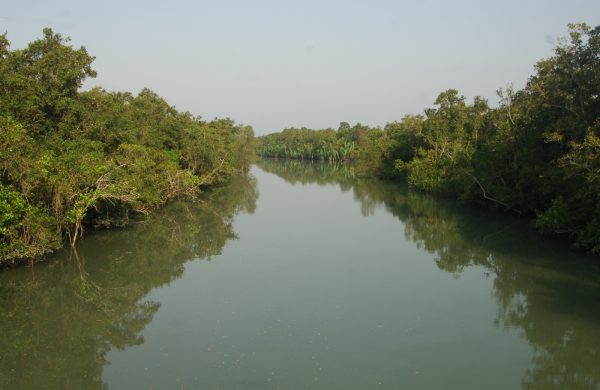Tranquil high tide puts wildlife at risk in Sundarbans
- Update Time : Saturday, July 19, 2025

Hosneara Parvin Khuku from Khulna
Frequent tranquil high tide in the Sundarbans due to sea level rise is causing depletion of many species of trees and wildlife habitats largely in the world’s largest mangrove forest according to Conservator of Forest (CF), Khulna Circle Md Imran Ahmed after visiting the Sundarbans.
“If the water level continues to rise, due to the climate change, many areas of the Sundarbans will go under water. And if the water stays there permanently, many species of trees and animals would die”, CF Imran Ahmed added.
The rising sea-level, which is behind the increasing salinity in the rivers along the Sundarbans—together with chemical refuges that foreign ships regularly discharge in the rivers—which brought about definite adverse changes in the vegetative pattern of the forest, CF Imran further said. The rise in salinity is also blamed on the Farakka Embankment which has reduced the flow of sweet water.
AZM Hasanur Rahman, Divisional Forest Officer (DFO), West division of the Sundarbans said, “In the past, the sea level never rose to where it is at present. If the water stays there permanently, the flora and fauna of the Sundarbans will be extinct and inhabitants of the forest will be homeless.” On the other hand, the saline water will have a serious impact on the soil of the forest and deplete the dense of forest, DFO Hasanur added.
Sunuram Roy, Chief Scientific Officer of Institute for Integrated Studies on the Sundarbans and Coastal Ecosystem (IISSCE) of Khulna University warned that the Sundarbans will be the worst victim of the sea level rise. He said, “The inundation of other parts of the country may be overcome, but the damage to the Sundarbans can hardly be recovered. If appropriate steps are not taken immediately, the Sundarbans might whiter away in future.
The Sundarbans cover an area of about 10,000 square kilometers, including the part in Indian’s West Bengal. The Bangladesh part of the Sundarbans, covering 6,017 square kilometers, is situated towards south of Khulna, Bagerhat and Satkhira districts along the Bay of Bengal. Of the total area, 4,143 square kilometres comprises land including 1,874 sq km land of water. The forest is the sanctuary for 425 species of trees, herbs, creepers and 246 species of wild animals such as spotted deer, estuarine crocodile, the famous Royal Bengal Tiger and many others.
Sources said about 3.14 million people including local fishermen, Bawalis, Mowalis, crab catcher and others directly or indirectly are dependent on the resources of the Sundarbans for earning their living.
The global warming has already made Bangladesh the most vulnerable country to climate change in the world. According to the climate watchdog of the United Nations, the Inter-governmental Panel on Climate Change (IPCC) reported in February, 2007 in Rome that if any precautionary step is not taken, the Sundarbans would go under sea water in 50 years.
It also reported that if the sea level rises up to 30 centimetres, the major portion of the coastal areas in Bangladesh would go under sea water in 30 years.
However, the Sundarbans took a direct hit from the climate change in November 15, 2007, when it was severally battered by the cyclone Sidr and in May 25, 2009 of cyclone Aila. About 26.5 percent of the mangrove forest was damaged by the cyclone completely and a large area partially.
The Royal Bengal Tigers—one of the most fascinating cats in the world and Bangladesh’s national mascot, are also under threat because of waning population of deer amid adverse climate change as the tigers mostly live on hunting deer, according to Prof Dr Rumana Rana, head of Forestry and Wood Technology Faculty of Khulna University (KU).
Moreover, salinity and river erosion have started taking their tolls on the green belts that surround the Sundarbans. Environmentalists fear that if corrective measures are not taken right now the green belts around the mangrove forest will face serious threat to their existence.












